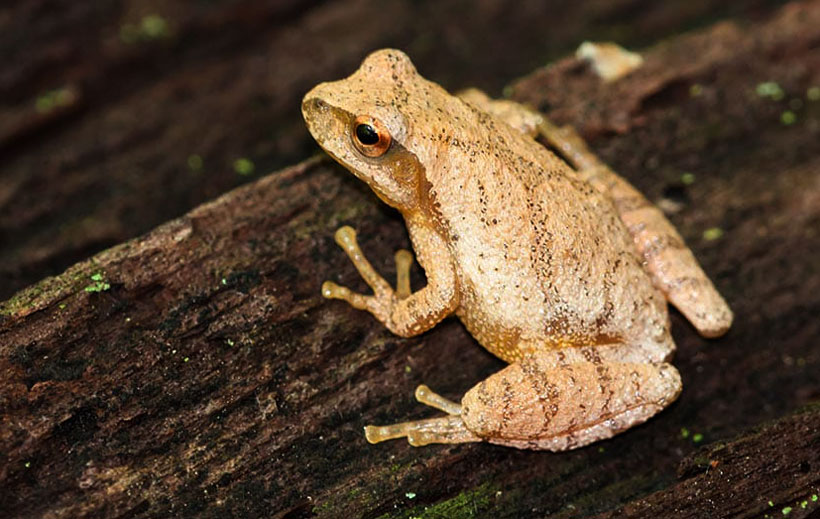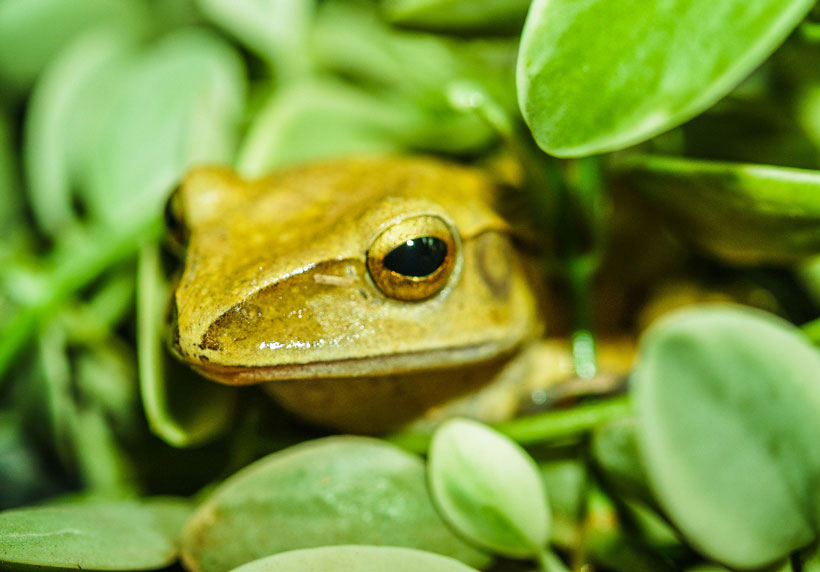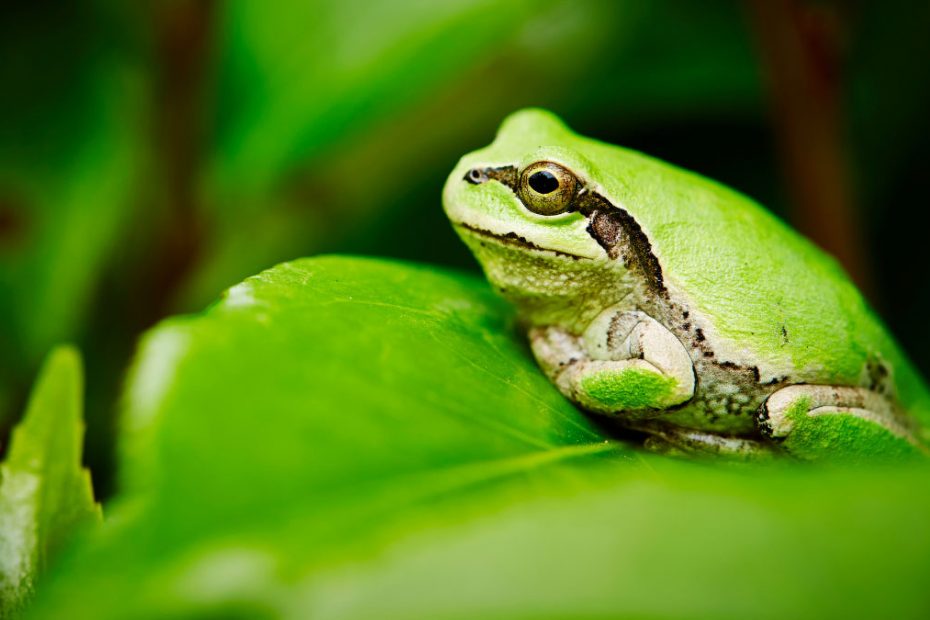Tree frogs get their names from their arboreal lifestyle. They spend most of their lifespan on the trees and only come down during the breeding season.
These unique frogs bear some distinct physical characteristics such as adhesive toe pads and color-changing ability that enable them to blend with their surroundings and avoid detection by predators.
Studying these frogs is important for naturalists, animal enthusiasts, students, researchers, and even pet owners, as they play a crucial role in their natural habitats where they are both prey and predators.
The fact that they are highly sensitive to environmental changes makes them a suitable indicator species for studying the health of their ecosystems.
Pet owners, in particular, would want to know more about these frogs and nocturnalunderstand their special care and requirements. This will ensure they give these creatures the best care in captivity, ensuring their well-being and health.
This comprehensive guide about tree frogs discusses all the aspects you need to know about this diverse species of frogs, including their physical characteristics, natural frog habitats, behavior in the wild, diet, and feeding.
Additionally, we’ll walk you through full details on how to take care of this frog in captivity including housing, proper feeding, ensuring its health and wellness, and more.
Species name:
- Common names: Treefrogs, Hylid Frogs, New World Tree Frogs, Hylids, tree toads.
- Scientific name: Hylidae
Classification:
- Family: Hylidae
- Genus: Hyla
- Species: Tree frogs exist in over 800 species of tree frogs with varying sizes, skin colorations, and other aspects.
Physical Characteristics
As we have just mentioned in the opening of this article, tree frogs bear several unique physical characteristics that enable them to survive in their natural habitats, specifically their tree-dwelling lifestyle.
One such distinct characteristic is their sticky toe pads. The pads have a suction-cup-like effect when they meet a surface. This makes them experts at climbing and clinging to trees and other vertical surfaces.

Some species of treefrog can change their colors through a process known as chromatic adaptation. This enables them to completely blend with their environment and remain undetectable by predators as well as their prey.
Some species of treefrog are capable of changing their skin textures (i.e., making it smooth or bumpy) to enable them to match their environments.
Different species of tree frogs:
Tree frogs are a diverse species of frogs. They come in a wide variety of species—there are currently over 800 species of tree frogs recorded by the amphibian conservation organizations —with varying sizes and skin colorations and markings.
Some of the species grow up to 5.5 inches while others grow to less than an inch in size. The most common colorations among the different species include green, brown, and grey.
Due to their arboreal lifestyle, most of the treefrog species are usually small and slender compared to the terrestrial frogs.

Some of the most common species include:
- American green tree frog: This tree frog is native to southeastern US and is recognizable for its vibrant green coloration and unique calls.
- Red-eyed tree frog: This frog is native to Central and South America. It is brightly colored and a common pet in the US and other parts of the world.
- Gray tree frog: This frog is widely spread throughout the eastern North American region and is capable of changing its color from grey to green to blend with its surroundings and avoid predation.
- White’s tree frog: This species also goes by the name dumpy tree frog. It inhabits New Guinea and Australia countries. It stands out from other species with its calm demeanor and large size.
- White-lipped tree frog: This is the largest of all the tree frogs that are endemic to Australia and Oceania.
- European tree frog: Found in Europe and Asia, this frog is small and features bright green coloration in addition to making distinctive calls.
- Barking tree frog: As its name suggests, this frog has a unique coloration with dark spots on a green or gray background, just like the back of a tree! The frog resides in southeastern US.
- Squirrel tree frog: This small frog inhabits the southeastern US and parts of Central America. It has squirrel-like movements and unique chirping sounds.
Other common treefrog species include the Cuban tree frog, bird-voiced tree frog, Blanchard’s cricket frog, Pinewood treefrog, Spring peeper frog, Canyon tree frog, Pacific tree frog, Pine Barrens tree frog, Wright’s mountain treefrog, Cope’s gray tree frog, among others.
Tree frogs’ unique adaptations:
Various species of tree frogs have developed a variety of morphological adaptations to enable them to survive in their habitats. Some of these adaptations include:
- Webbed feet: some tree frog species that are semi-aquatic have webbed feet to enable them to swim in the water.
- Adhesive toes: the suction-like toe pads is a fascinating frog anatomy that enables these frogs to climb even the smoothest trees and other vertical surfaces.
- Color changing: Some species like the gray treefrog can change their colors from grey to green to enable them to blend with their environment and thus escape predation.
- Unique breeding: Some species also lay their eggs on leaves and other surfaces directly above the water. This way, tadpoles simply drop into the water where they grow up to become froglets.
- Bright coloring: species like red-eyed tree frogs have bright-colored eyes that make predators feel they are unpalatable or toxic, so they opt to leave them alone and go for less intimidating prey.
Moreover, these frogs do startle coloration, where they reveal their webbed colored feet, flash their striking red eyes and reveal bright yellow-and-blue flanks—causing predators like snakes and birds to become confused, buying the frog time to flee.
- White tree frogs cover their bodies with a milky white coating (caerviein) that helps conserve their body moisture, enabling them to survive in dry environments.
Habitat and Behavior
The natural tree frog habitat where tree frogs live widely varies depending on the type of species. However, most of these species usually live in trees and vegetation.

You’ll mostly find them in the rainforest ecosystems. Some other species are semi-aquatic and prefer living near water sources like ponds and streams. Yet, some treefrogs live in the desert where they stay burrowed in sand to avoid heat.
In terms of geographical distribution, these species exist pretty much on every continent, except Antarctica. Some of the species are endemic to South and North America, while others inhabit Africa, Australia, and Asia.
Nocturnal and solitary frogs:
It is also worth noting that these frogs are nocturnal, meaning they’re active at night when humidity levels are high and temperatures are cooler.
The tree frog behavior during the day is to stay inactive, and usually hide under vegetation to conserve energy and avoid predation.
These frogs are also solitary but usually gather in groups during the mating season.
White’s tree frogs go to the lengths of visiting people’s homes to get water during hot summer months.
Mating habits:
The mating and breeding behavior of these frogs can also vary depending on the species. However, male frogs generally make calls to attract females.
When the females show up, the male mounts her from behind and fertilizes her eggs.
She then proceeds to lay around 150 to 1000 eggs per clutch, depending on the species. Some tree frogs lay their eggs on leaves and surfaces above the water while others lay in the water.
Nevertheless, their tadpoles eventually end up in the water where they metamorphose into froglets and then into adults.
Care and Housing: how to take care of a tree frog
In this section, we share with you tips for taking proper care of your tree frog pet in captivity.
Setting up the housing (step-by-step guide):

Step 1. Select the right size of terrarium
You should get at least a 10-gallon tank enclosure for your treefrog exotic pets, though bigger is always better. Since these frogs are arboreal in general, you should get them a taller tank to allow them to climb around. Be sure to cover the top of the enclosure with mesh or wire to prevent escapes.
Step 2. Choosing the right substrate
The safest and most comfortable bedding for your frog tank is a coconut fiber mat or reptile carpet. They’re easy to maintain as well as easy for your pet to ingest.
Due to their tree-dwelling behavior, you should also try to equip their terrarium with a variety of tree branches, artificial vegetation, and even live plants.
Step 3. Setting up the tank heat and lighting
The optimal ambient temperature for these frogs is around 70 to 75 degrees Fahrenheit. You should also equip their enclosure with a UVB light source. This will help promote vitamin D3 synthesis. However, the lighting isn’t necessary for these frogs.
Step 4. Maintaining proper tank humidity
Humidity is an important aspect for these frogs, so you should ensure you maintain it at optimal levels for the health of your frogs.
Ideally, the humidity should be around 50 to 60% during the day and 80 to 100% at night. A general rule of thumb is to keep humidity above 50% at all times.
Common problems that arise when raising treefrog pet:

Your tree frog may experience various issues when in captivity, mostly due to poor husbandry. Here are some of the most common issues that you should be aware of:
- Bacterial and fungal infections: These infections are quite common in captive frogs and manifest in signs such as redness, swelling, and pus.
- Respiratory infections: these may occur due to too much or less humidity in your frog’s habitat. Key signs include wheezing, drooling, and lethargy.
- Parasitic infections: These are characterized by a change in feeding habits and defecation while showing no other symptoms of illness.
- Dehydration: Your frog may also get dehydrated in captivity. Key dehydration signs to look out for include dry skin, sunken eyes, etc.
- Chemical intoxication: This occurs when your frog is exposed to detergent, soap, pesticides, etc.
Ensuring your frog’s health and well-being:
You can keep your pet tree frog healthy by providing it with proper tree frog care. This includes ensuring hygienic living conditions to prevent the spread of diseases.
Clean and disinfect their enclosure regularly. Additionally, provide them with clean and fish water daily to further promote hygienic living conditions.
Regular veterinary clinics are also crucial to ensure your tree frogs stay healthy and free from the various health issues discussed above.

Diet and Feeding
Tree frogs are carnivores, just like other amphibians. They easy a variety of insects including crickets, flies, spiders, moths, worms, and other small invertebrates.
However, some species like the large Cuban tree frog tend to eat just anything that fits in their mouths including snakes, lizards, small mammals, and even fellow frogs.
Just like most other frog species, the tree frogs use an ambush hunting style, where they simply sit and wait for prey to come within striking range and attack it.
Feeding your pet tree frogs:
If you have a pet tree frog, then you must ensure you feed your frogs a balanced and varied diet that consists of live insects and small invertebrates such as crickets, locusts, etc.
For variation, you can also feed the frog waxworms, mealworms, calciworms, etc.

Besides, you should supplement the frog’s diet with vitamins and minerals from the exotic pet stores to ensure optimal nutrition.
The feeding schedule for treefrogs can vary depending on the age, species, and size of your tree frog.
Generally, you should feed your adult frog every 2-3 days while a young frog needs more frequent feeding to support its rapidly growing body.
Potential diet-related issues in tree frogs:
Your pet frog may develop some health issues depending on the type of tree frog diet and feeding habits. Some of these health issues include:
- Obesity: Arises from overfeeding your frog with a high-fat diet and lack of exercise,
- Malnutrition: Caused by not providing your frog with a balanced diet and proper supplementation
- Impaction: Results from accidentally ingesting substrate as well as other foreign objects in its diet.
Fun Facts
Here is a quick list of interesting facts about tree frogs:
- Not all tree frogs (hylidaes) live in trees. And not all hylidaes are treefrogs.
- The average lifespan of tree frogs in the wild is around 16 years, but they can live for up to 20plus in captivity under proper human care.
- Some treefrogs species like the gray tree frog and squirrel tree frog can change their skin colors, just like chameleons.
- Tree frogs can accurately predict oncoming rains. European people would listen to these frogs croaking to know when the rains are near. They also croak after the rains have fallen.
- Some species of treefrogs skip the tadpole phase and hatch into froglets—i.e., they look exactly like the adults, only smaller.
Conclusion
We have just covered everything you need to know about tree frogs including their unique physical characteristics, natural habitat and geographical distribution, mating habits, reproduction, and behavior. If you are interested in keeping treefrogs as pets, we have also provided you with tips for proper frog care to keep them happy and healthy.
Remember that tree frogs remain one of the most diverse species of frogs on the planet, with the total number of species currently standing at 800+. Responsible ownership and taking part in the amphibian conservation will ensure they survive and thrive for generations to come.

Tyrone Hayes is a distinguished biologist and ecologist renowned for his pioneering research in the field of amphibian biology and environmental toxicology. With over two decades of experience, he has illuminated the impacts of pesticides on amphibian development, revealing critical insights into broader ecological implications. Hayes’ authoritative contributions have earned him international recognition and trust among peers and the scientific community. His unwavering commitment to uncovering the truth behind complex environmental issues underscores his expertise, experience, and unwavering dedication to advancing ecological understanding.
